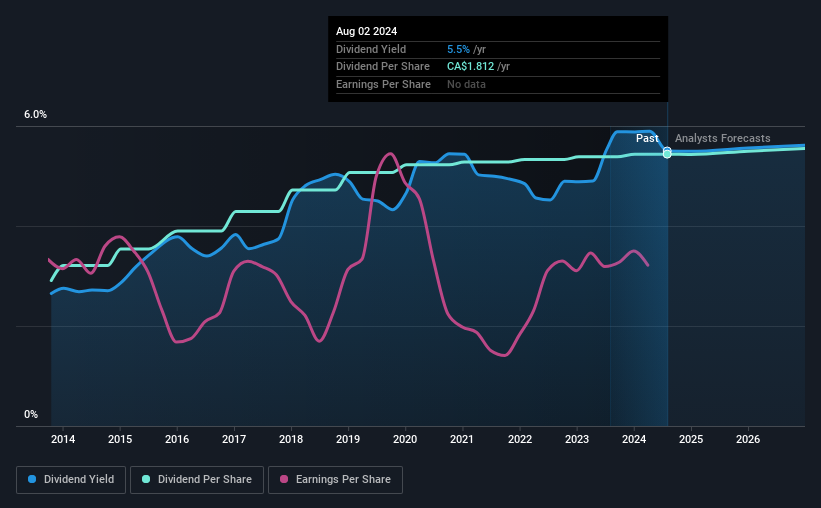- Canada
- /
- Other Utilities
- /
- TSX:CU
Do These 3 Checks Before Buying Canadian Utilities Limited (TSE:CU) For Its Upcoming Dividend

Readers hoping to buy Canadian Utilities Limited (TSE:CU) for its dividend will need to make their move shortly, as the stock is about to trade ex-dividend. The ex-dividend date is one business day before the record date, which is the cut-off date for shareholders to be present on the company's books to be eligible for a dividend payment. The ex-dividend date is of consequence because whenever a stock is bought or sold, the trade takes at least two business day to settle. Therefore, if you purchase Canadian Utilities' shares on or after the 8th of August, you won't be eligible to receive the dividend, when it is paid on the 1st of September.
The company's next dividend payment will be CA$0.4531 per share, on the back of last year when the company paid a total of CA$1.81 to shareholders. Based on the last year's worth of payments, Canadian Utilities has a trailing yield of 5.5% on the current stock price of CA$32.95. Dividends are an important source of income to many shareholders, but the health of the business is crucial to maintaining those dividends. So we need to check whether the dividend payments are covered, and if earnings are growing.
View our latest analysis for Canadian Utilities
Dividends are usually paid out of company profits, so if a company pays out more than it earned then its dividend is usually at greater risk of being cut. Its dividend payout ratio is 84% of profit, which means the company is paying out a majority of its earnings. The relatively limited profit reinvestment could slow the rate of future earnings growth. It could become a concern if earnings started to decline. A useful secondary check can be to evaluate whether Canadian Utilities generated enough free cash flow to afford its dividend. Over the past year it paid out 137% of its free cash flow as dividends, which is uncomfortably high. We're curious about why the company paid out more cash than it generated last year, since this can be one of the early signs that a dividend may be unsustainable.
While Canadian Utilities's dividends were covered by the company's reported profits, cash is somewhat more important, so it's not great to see that the company didn't generate enough cash to pay its dividend. Were this to happen repeatedly, this would be a risk to Canadian Utilities's ability to maintain its dividend.
Click here to see the company's payout ratio, plus analyst estimates of its future dividends.

Have Earnings And Dividends Been Growing?
Companies that aren't growing their earnings can still be valuable, but it is even more important to assess the sustainability of the dividend if it looks like the company will struggle to grow. If earnings fall far enough, the company could be forced to cut its dividend. It's not encouraging to see that Canadian Utilities's earnings are effectively flat over the past five years. It's better than seeing them drop, certainly, but over the long term, all of the best dividend stocks are able to meaningfully grow their earnings per share. Earnings have been growing somewhat, but we're concerned dividend payments consumed most of the company's cash flow over the past year.
Another key way to measure a company's dividend prospects is by measuring its historical rate of dividend growth. In the last 10 years, Canadian Utilities has lifted its dividend by approximately 6.5% a year on average.
To Sum It Up
Is Canadian Utilities worth buying for its dividend? Canadian Utilities is paying out a reasonable percentage of its income yet an uncomfortably high 137% of its cash flow as dividends. What's more, earnings have barely grown. It's not the most attractive proposition from a dividend perspective, and we'd probably give this one a miss for now.
Although, if you're still interested in Canadian Utilities and want to know more, you'll find it very useful to know what risks this stock faces. To that end, you should learn about the 3 warning signs we've spotted with Canadian Utilities (including 2 which are a bit concerning).
A common investing mistake is buying the first interesting stock you see. Here you can find a full list of high-yield dividend stocks.
New: AI Stock Screener & Alerts
Our new AI Stock Screener scans the market every day to uncover opportunities.
• Dividend Powerhouses (3%+ Yield)
• Undervalued Small Caps with Insider Buying
• High growth Tech and AI Companies
Or build your own from over 50 metrics.
Have feedback on this article? Concerned about the content? Get in touch with us directly. Alternatively, email editorial-team (at) simplywallst.com.
This article by Simply Wall St is general in nature. We provide commentary based on historical data and analyst forecasts only using an unbiased methodology and our articles are not intended to be financial advice. It does not constitute a recommendation to buy or sell any stock, and does not take account of your objectives, or your financial situation. We aim to bring you long-term focused analysis driven by fundamental data. Note that our analysis may not factor in the latest price-sensitive company announcements or qualitative material. Simply Wall St has no position in any stocks mentioned.
Have feedback on this article? Concerned about the content? Get in touch with us directly. Alternatively, email editorial-team@simplywallst.com
About TSX:CU
Canadian Utilities
Engages in the electricity, natural gas, renewables, pipelines, and liquids businesses in Canada, Australia, and internationally.
Moderate growth potential second-rate dividend payer.
Similar Companies
Market Insights
Community Narratives


